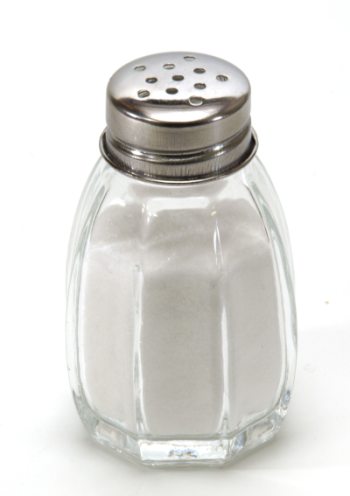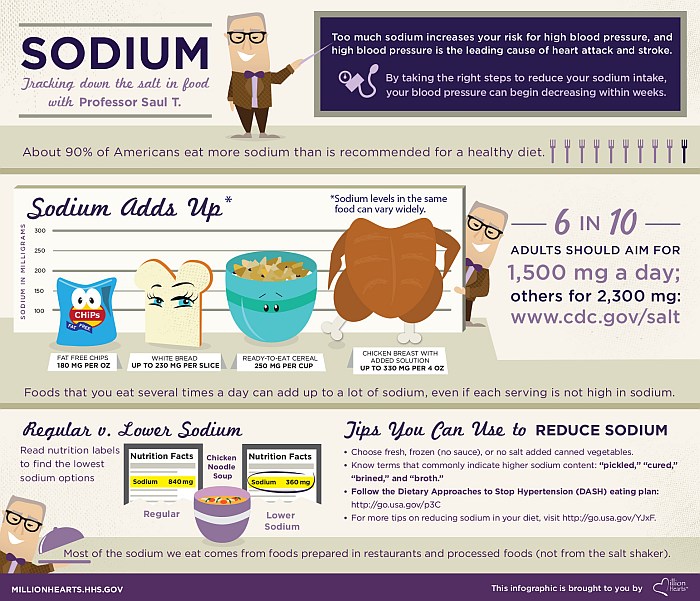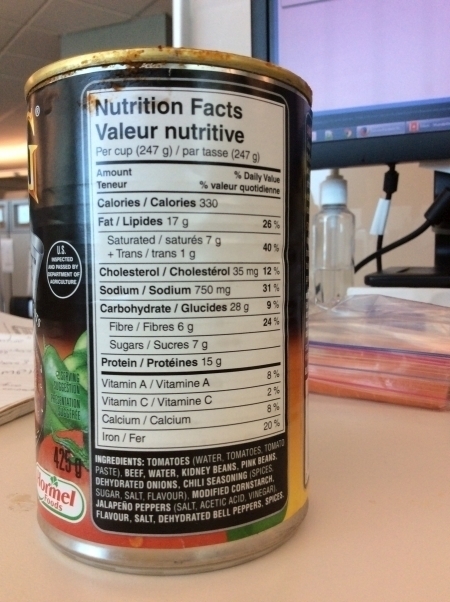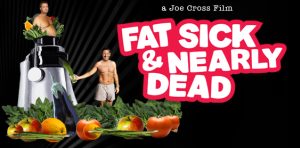Salt and sodium often get a bum rap. The fact is, sodium is an essential electrolyte in the body. It helps muscles to function, regulates the balance of fluids and allows nerves to send out impulses.
The right balance of sodium is essential to our lives whereas too much sodium can lead to health problems, such as high blood pressure. This increases the risk of atherosclerosis (aka hardening of the arteries) and heart attack and stroke.
 Table salt (sodium chloride) is made of sodium (40% by weight) and chloride (60% by weight).
Table salt (sodium chloride) is made of sodium (40% by weight) and chloride (60% by weight).
A teaspoon of salt containing 2,300 milligrams of sodium. The American Heart Association recommends eating less than 1,500 milligrams of sodium each day (about 3/4 teaspoons or 3.75 grams of salt per day) and no more than 2,300 mg (one teaspoon and 6 grams of salt per day).
Actually as a parent of a child that suffers from Kidney Disease I have learned quite a bit about Sodium.
It is important to keep sodium down to 500 mg per meal and only 250 mg for any snack
Sodium and Weight Loss
Sodium does not have any calories and does not affect weight. However, too much sodium can make a person retain fluid, which in turn can make a scale go up.
Even if dieters know its “only water weight,” seeing a scale rise for any reason can be discouraging.
Sodium can also make a person feel bloated (surprisingly, the solution is to drink more water).
Caution: Often food high in sodium will be high in calories. Although the sodium may only cause fluid retention, the French fries the sodium is on can definitely lead to a weight gain.
Sodium hides
Generally speaking, the salt shaker is not the enemy. No one is likely to dump a teaspoon of salt on a baked potato and devour it. Ugh. And unless the family cook is heavy handed, sodium can be well controlled in the home.

Sodium is found naturally in many foods and that isn’t a big problem either.
The real enemy is that salt is hidden in so many prepackaged and prepared foods. Sadly, so many foods that we find tasty are the result of high levels of sodium. Even at the deli counter, that delicious sliced turkey or roast beef can be full of sodium.
Even foods touted as “Low Sodium” can be misleading. Federal law requires food manufacturers to print the sodium content on their nutrition labels. When buying processed foods, carefully read the labels and then use common sense.
Sodium alternatives
Spices and herbs are a great way to season food without paying the too-much-sodium price. These include basil, oregano, garlic, onion powder, sage, bay leaves, cilantro, allspice, thyme, and black pepper. And don’t forget lemons and limes.
When shopping, choose the low sodium canned soups and canned vegetables, low salt cold cuts.
The list of high sodium foods to avoid represents a good portion of any supermarket – and includes processed meats, canned entrees (e.g., chili), instant soup, some cheeses, pizza, tomato sauces, and many varieties of breads, cereals! And the list goes on…
| Table 1. Sodium Comparisions—As sodium content increases, so does the level of processing.1 | |||
| Food Item (1 serving) | Least Processed Low Sodium < 100 milligrams (mg) per serving | Moderately Processed Elevated Sodium 100-350 milligrams (mg) per serving | Most Processed High Sodium >350 milligrams (mg) per serving |
| Apple | Raw apple, 2 mg | Apple pie (frozen), 208 mg | Apple pie (fast food), 400 mg |
| Bread | Low sodium bread, 7 mg | White Bread, 114 mg | Plain Bagel, 561mg |
| Cooking fats | Vegetable oil, 0 mg Butter(unsalted), 2 mg | Butter (salted), 116 mg Margarine, 140 mg | |
| Chicken | Chicken, 69 mg | Chicken salad, 290 mg | Chicken pie (frozen), 907 mg Chicken noodle soup, 1,107 mg Chicken dinner (fast food), 2,243 mg |
| Corn | Fresh corn, 1 mg Frozen corn,7 mg | Corn flakes, 256 mg | Canned corn, 384 mg |
| Cucumber | Raw Cucumber, 2 mg | Sweet pickle, 128 mg | Dill pickle, 928 mg |
| Flavorings and Marinades | Lemon, 1 mg | Ketchup, 156 mg | Soy sauce, 1,029 mg |
| Seasonings | Herbs, 1 mg | Mayonnaise, 103 mg | Salt, 1tsp-1,938 mg |
| Potatoes | Potato, 5 mg | Potato chips, 200 mg | Mashed potatoes (instant), 485 mg Potato salad, 625 mg |
| Dairy | Plain yogurt, 105 mg | Milk, 122 mg Buttermilk, 257 mg | Choc. Pudding (instant), 470 mg |
| Red Meat | Steak, 55 mg | Ham (uncooked), 220mg | Corned beef, 802 mg Jumbo burger (fast food), 990 mg Lunch Meat (beef, pork), 540 mg |
| Tomatoes | Raw Tomato, 14 mg | Salsa, 200mg | Tomato sauce, 1,498 mg |
| Fish | Fresh Tuna, 50 mg | Tuna, canned, 384 mg | Tuna pot pie (frozen),715 mg Fish sandwich (fast food), 882 mg |
| Nuts | Peanuts, unsalted, 8mg Peanut butter, 81 mg | Peanut brittle, 145 mg | Dry roasted peanuts, salted, 986 mg |
| Cheese | Low sodium cheddar, 6 mg | Cheddar cheese, 176 mg Cottage cheese, 257 mg | American cheese, 406 mg |
| 1Notice that most “elevated” to” high” level sodium foods are processed, meaning they are more likely to contain added ingredients such as preservatives- which means more salt. | |||




